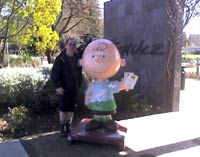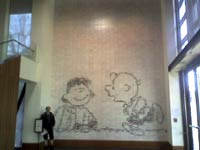| Good Grief, Charlie Brown! You Have a Museum, by Alice Zyetz |
|
|
Some
road trips require emotional support. Maybe a tire goes
flat, or a traveling companion suddenly gets on your
nerves. If you ever find yourself needing a security
blanket, or a doghouse to climb into, or some advice
from a bossy, know-it-all kid, then head straight for
the Charles M. Schulz Museum, in Santa Rosa, Calif.,
where the "Peanuts" comic strip always sets
life right. Our "RVing with Alice and Jaimie"
columnist, Alice Zyetz, took a tour of the museum and
came away smiling.
|
||
One of the many pleasures of RV travel is finding out-of-the-way places and having the time to stop and enjoy them. North of San Francisco and not far from the great wineries of Napa and Sonoma counties is the city of Santa Rosa, Calif., the home of the Charles M. Schulz Museum.
Known to all as "Sparky," Schulz was the creator of Charlie Brown, Lucy, Snoopy and the whole "Peanuts" comic-strip gang for more than 50 years. Stepping inside the museum immediately transports visitors to memories of Linus' security blanket, the kite-eating tree, Lucy's psychiatry booth, the football carefully placed on the green and, always, Snoopy with his scarf flying as he controls his plane on top of his doghouse.
Generations of children have enjoyed the simply drawn figures, but as adults we respond to the human condition captured in the strips: the perennial klutz always willing to try again, somehow believing that this time it will be different; the fantasy life of Snoopy, a Walter Mitty beagle wearing extra-large sunglasses as Joe Cool or a World War I pilot's helmet to fight the Red Baron; and the ever-elusive red-haired girl, the idealized love object we have all yearned for at some period in our lives.
Entering the Great Hall
The museum has more than 6,000 square feet of gallery space
with permanent and changing exhibitions of the original strips
and memorabilia, so there is no sense of crowding. As you
approach the exhibits through the Great Hall, the first things
you see are two huge works of art by Yoshiteru Otani. The
first is "Morphing Snoopy," a work that began as
cut paper and was then converted into 43 layers of maple veneer;
it chronicles the transformation of Snoopy from his humble
start as a realistically rendered and rather ordinary beagle
in the 1950s to the star character of the 1990s strip. On
the back wall is the second work, a two-story black-and-white
mural depicting Lucy and Charlie Brown. As you approach it,
you discover the wall is made up of many ceramic tiles (3,588
tiles, in fact), each one a separate, authentic "Peanuts"
comic strip, arranged to provide the details of the two characters.

|
|||
The exhibits
The individual galleries flow into each other through archways
that keep the space open and keep the traffic moving easily.
Beside the original strips are biographical materials chronicling
Schulz's life and the life of the characters, along with samples
of earlier comic strips that influenced Schulz and special
exhibits relating to the cartoonist's art. When I visited
the museum in the summer of 2007, comic strips from other
cartoonists lined the walls, illustrating the influence Schulz
has had on his colleagues. One strip showed Garfield looking
in the mirror and seeing Snoopy gazing back at him. Next frame:
Garfield with his classic disgusted look says, "It's
going to be one of those Mondays."
The second part of the exhibit is devoted to the use of "Peanuts" characters in political cartoons. For example, when a 19-year-old German pilot flew his Cessna from Hamburg, Germany, to Moscow in 1987 -- evading Soviet air defenses and landing boldly in Red Square -- the Russians were embarrassed. A Soviet cartoon of that year shows Snoopy as the World War I ace sitting on his doghouse in Red Square, his paws still extended at the invisible controls. One Russian soldier says to the other soldier, "Let's see the Comrades in the Air Defense explain this one." Exhibit after exhibit brought similar smiles and memories. By the time I finished the first floor, I was in love all over again with the characters and the power of the great comic strips: "Pogo," "Peanuts," "Calvin and Hobbes" and "Doonesbury," to name a few.
Surrounding the museum
The second floor of the museum houses a re-creation of Schulz's
studio, a research library, the archives, an auditorium and
an education room that hosts hands-on activities and classes.
Two films provide a glimpse into the artist's life and craft
as well as into the creation of the "Peanuts" gang.
Outside are some sculptures, gardens and a labyrinth. Across
the street is the Redwood Empire Ice Arena that Sparky frequented
and the small café named "Warm Puppy," where
he ate lunch every day. Both businesses are still in operation.
One table at the café is set aside for Sparky as a
memorial.
More museums devoted to the art
I've been to many museums over the years. I've been inspired
by Rodin sculptures, the "Mona Lisa," Van Goghs
and Picassos, but I don't remember coming away from a museum
with as big a smile as I did in Santa Rosa. For more cartoon
museums in the United States, visit the following Web sites:
- The Cartoon Art Museum in San Francisco, California
- The Oklahoma Cartoonists Collection at the Toy & Action Figure Museum in Pauls Valley, Oklahoma
- The
National Cartoon Museum in Stamford, Connecticut
(June 23, 2021 note: The National Cartoon Museum is no longer operating. Its collection has been merged with the Billy Ireland Cartoon Library & Museum, affiliated with Ohio State University in Columbus, Ohio.)
In Brussels, Belgium, you can visit the Belgian Centre for Comic Strip Art.
Happy travels!
Alice Zyetz
9/16/07
(Links updated 12/6/21, RTA)


